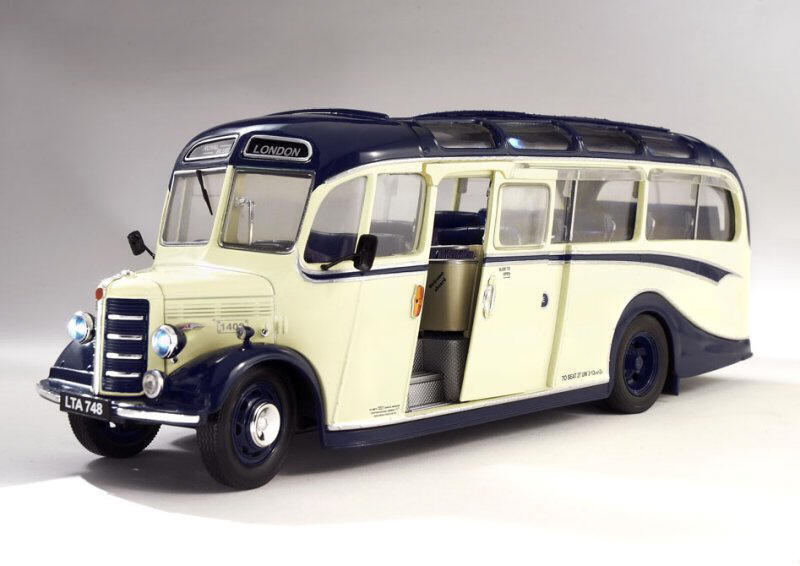
Original Classics 1:24 Bedford OB - Royal Blue
Reg. LTA 748, Fleet No.1409
Released March 2006
Review by Andy McClelland
When this model
arrived I could not believe how wonderful it looks! I have several 1:76
scale OBs but this model knocks them all into a cocked hat! Measuring
303mm long x 92mm wide x 108mm high, and weighing in at 1.15kg (or
slightly more than a packet of sugar!) its whole appearance shouts
“authenticity”! In my opinion the build quality and finish are
second to
 none!
Admittedly I have never travelled on a Royal Blue OB, and have only two
b/w off-side photos with which to compare it (one of LTA 750), but just
looking at the model evokes memories of similar vehicles with their
characteristic “whine” as they pulled up long hills in third!
none!
Admittedly I have never travelled on a Royal Blue OB, and have only two
b/w off-side photos with which to compare it (one of LTA 750), but just
looking at the model evokes memories of similar vehicles with their
characteristic “whine” as they pulled up long hills in third!
To set the model in context, it is undoubtedly modelled as the vehicle appears today. (I understand the present owner of the prototype is currently restoring the vehicle.) In this way it is different from the projected models of Sunstar who say they will be releasing their models as they were ex-works. Little giveaways are the exterior mirrors, which are larger than those of the original vehicle (and come supplied separately, and which I have not yet applied); the trafficators would have been of the semaphore type when new; the on-board fire extinguisher looks too modern for original equipment, there is a tacho in the cockpit, and rather uncharacteristic large red rear lights are fitted in addition to the normal “glow worm” fittings. Fleet no 1409 was delivered to Western National in 1950 as a 29-seater and was painted in that company’s green and cream livery. In 1955 Western National and Southern National repainted many of their OBs into blue and cream livery, changed the off-side destination screen to Royal Blue and reduced the seating to 27 for use as duplicates on Royal Blue services, and this is the version that the model presents, with a destination screen showing “London”.
To me, as an ex-Royal Blue driver (though not of the OB era I hasten to
add!!) it appears that the manufacturers have got the livery spot-on,
with both exterior and interior detailing to a very high standard. The
front end with its blue mudguards, cream bonnet, silver bonnet handles,
twin destination screens behind glass, and single driver’s windscreen
wiper all ring true. As well as the normal headlights and
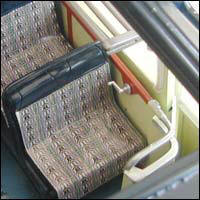 sidelights
there is also a single near-side foglight above the bumper,
sidelights
there is also a single near-side foglight above the bumper, although the
photos I have suggest that this was usually carried below the bumper;
but who can say all vehicles were absolutely identical? Carrying on
round the outside of the model the front wheels
(slightly narrower-gauge than the rears) are steerable from the steering
wheel inside, the sliding door (with detailed handle) is a perfect fit,
legal lettering is present (although it appears a little small) together
with UW markings. The side fleetnames are of the typical Royal Blue
format but instead of the “flying wheel” motif between the words Royal
and Blue, the words “Western National” appear in a very small circle.
I’m not sure if this is authentic or not. The distinctive Vista flash
and the sweep of the blue livery behind the rear wheels make for a very
attractive model.
Looking at the model from a rear ¾-view endorses the superb appearance.
Below the split rear windscreen appears the fleet name. Below this is
the rear number plate flanked by horizontal lights (turn or stop?), and
outboard of these appear the two uncharacteristically large rear lights.
The rear boot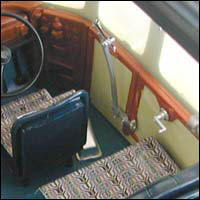 doors carry the fleet name, fleet number and a detailed
door handle. Finally, at the rear, the bumper includes the
“Bedford-Duple” silver lettering.
doors carry the fleet name, fleet number and a detailed
door handle. Finally, at the rear, the bumper includes the
“Bedford-Duple” silver lettering.
The offside of the model, in addition to the fleetname, shows the fuel
cap and fuel cut-off in 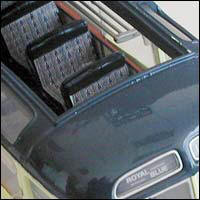 the correct positions and the emergency door has
a very convincing handle (the continuation of which can be seen on the
inside of the coach). The offside of the bonnet carries the fleet
number. One nice touch that a 1:24 model is able to show is the narrow
glass “slats” that appear on the top outsides of the side windows.
(Sorry, I don’t know what the proper
name for these is!)
the correct positions and the emergency door has
a very convincing handle (the continuation of which can be seen on the
inside of the coach). The offside of the bonnet carries the fleet
number. One nice touch that a 1:24 model is able to show is the narrow
glass “slats” that appear on the top outsides of the side windows.
(Sorry, I don’t know what the proper
name for these is!)
The roof area features the very attractive opening sunroof. Again, this
is an excellent fit, and gives an exceptionally good view of the
interior of the model, as do the roof quarterlights. It is incredible
how detailed the interior is. There are the correct number and
positioning of seats with extremely well-represented moquette and
leatherette upholstery and metal grab rails, a convincing floor
covering, individual window winders (off-side only ??), interior door
fittings and interior grab handles for the sunroof, and
perfectly-sculptured luggage racks above the seats. There is also a
modesty screen with the words “Welcome Aboard” (I think this must be a
“modern” touch!)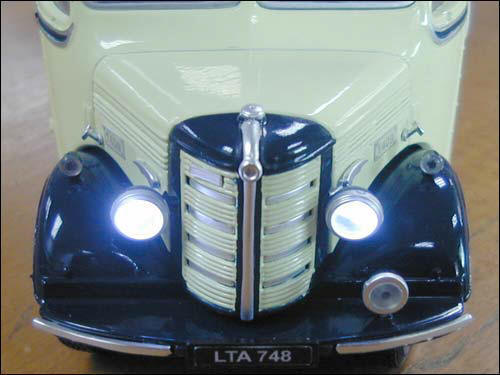
The front interior is dominated by the cockpit and the front passenger seats that we always used to fight for as kids! Although the OB lacked many of the “bells and whistles” of later vehicles, what it did have is very well represented in the model. As well as the speedometer, fuel gauge and warning lights, this model also has the aforementioned tacho. There is a large red fire extinguisher immediately in front of the front nearside passenger’s seat, a lovely representation of the long gear lever and guard rail immediately behind the engine, and representations of various lighting and destination display switches to the right of the driver.
This
brings us to the base of the model. Fairly uncomplicated, it does show
the off-set prop shaft running to the
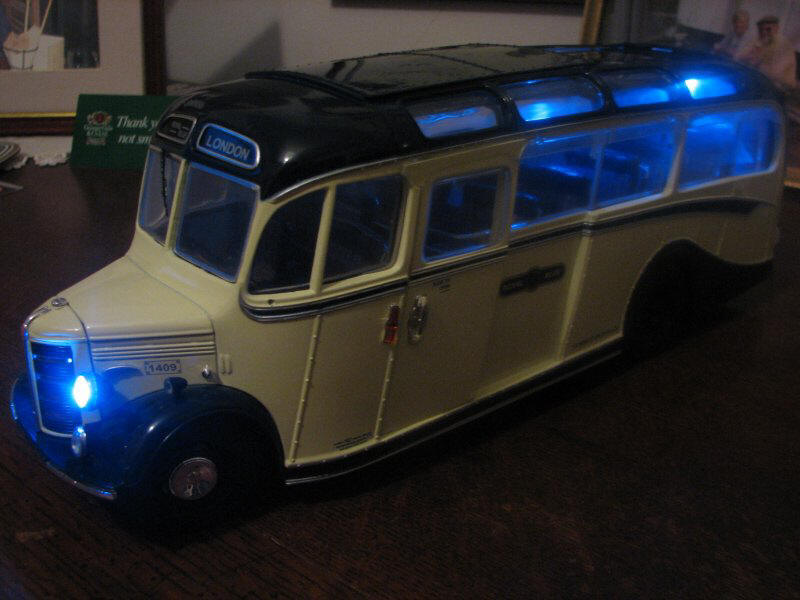 off-set differential of these
vehicles. A nice touch! Also in the base is what I consider to be the
model’s Achilles heel – the battery compartment (two AAs) and on-off
switch! Billed as features of
off-set differential of these
vehicles. A nice touch! Also in the base is what I consider to be the
model’s Achilles heel – the battery compartment (two AAs) and on-off
switch! Billed as features of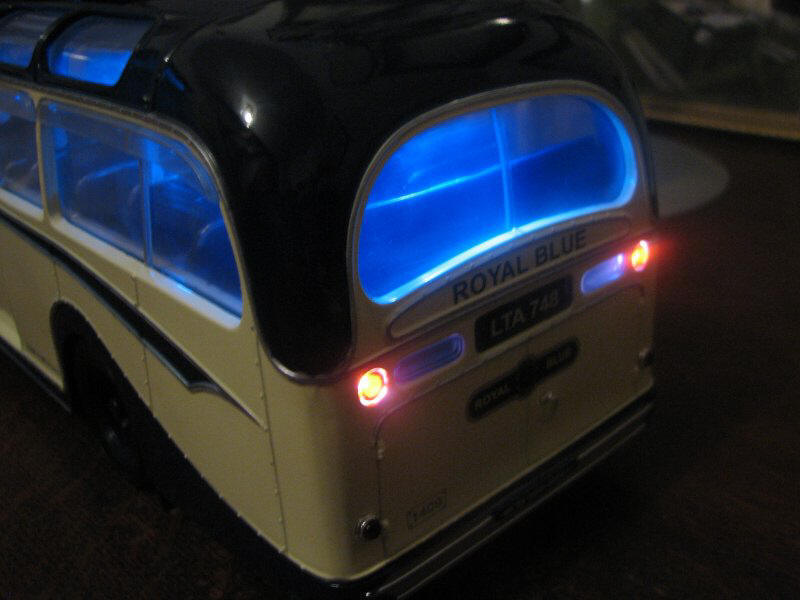 the model, the headlights, rear lights and
two interior lights do light up. The headlights are fine. The rear
lights are certainly far too large and bright for a 1950s OB, although
the present owner of the prototype may have had to add these to conform
to traffic regulations.
There are two interior lights, both in a central position – one above
the rear seats and one halfway down the coach immediately behind the
sunroof aperture. Again these seem to me to be far too bright for a
vehicle of this age and they give off a blue neon-like light. They also
have the effect of having a flood-lit rear end whilst the front end is
in total darkness!
the model, the headlights, rear lights and
two interior lights do light up. The headlights are fine. The rear
lights are certainly far too large and bright for a 1950s OB, although
the present owner of the prototype may have had to add these to conform
to traffic regulations.
There are two interior lights, both in a central position – one above
the rear seats and one halfway down the coach immediately behind the
sunroof aperture. Again these seem to me to be far too bright for a
vehicle of this age and they give off a blue neon-like light. They also
have the effect of having a flood-lit rear end whilst the front end is
in total darkness!
List price of the model is £99 and I understand that, at the time of writing, Original Classics are almost sold out of their run of 500 models. I believe the model shows true value for money, but, although I am absolutely delighted with it and the manufacturers have announced further releases (Crosville, West Yorkshire, Southdown and British Railways) this will certainly be the only one I will buy for financial and display/storage reasons!
(Note: One “minus” point – my model arrived without a front number plate! I informed Bernard at Original Classics and he put a replacement in the post immediately.)
AM
The opinions offered in the reviews on this page remain those of the author, and do not necessarily represent the of views of The Model Bus Website.